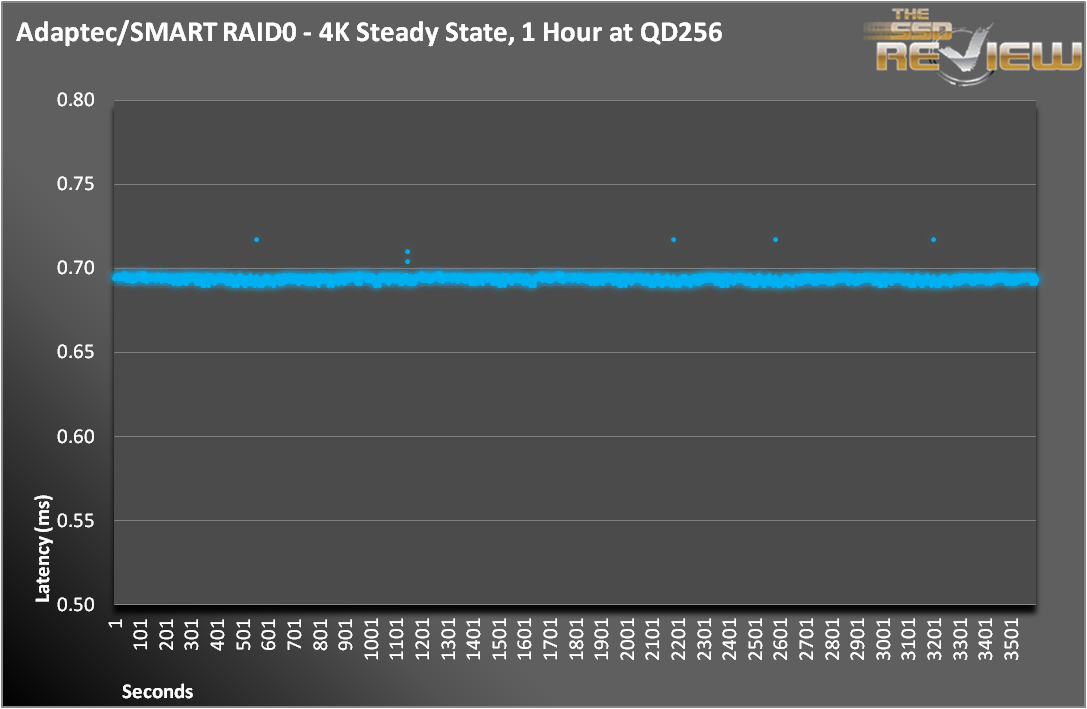ADVANCED WRITE TESTING
With the following tests, we stressed the drives using random 4KiB write workloads across the entire span for at least 24 hours. Every second, we record the average IOPS during that one second. Normally this exposes weak SSD controllers that become overwhelmed with excess P/E cycles. For RAID cards, we are measuring the performance of both the ROC and the SSDs.
With RAID adapters, there is an extra level of management that may obfuscate the actual performance of the SSDs. Since we know for a fact that the SMART Optimus drives enter steady-state very quickly and remain very stable throughout prolonged tests, any hiccups we may observe should be caused by the RAID controller. That is the intent, anyway. The following graphs show the final 60 minutes of our 24 hour torture test.
The results can’t be described as anything less than fantastic. As impressive as the graph is, it actually doesn’t do the ASR-72405 and Optimus drives justice. Looking at the raw data, a couple of numbers stood out. The first is that 99.6% of all 1s averages were under 0.7ms. Impressive, right? How about this – 98.81% of all 1s averages were between 0.69 and 0.70ms! This is made all the more impressive since the ASR-72405 was in write-through mode, meaning it was not using its onboard cache.
 The SSD Review The Worlds Dedicated SSD Education and Review Resource |
The SSD Review The Worlds Dedicated SSD Education and Review Resource | 


In many published reports a single optimus cannot provide latency performance within that tight of a range. These are obviously system cache results.
All caching was disabled, except for any write coalescing that the ROC was doing behind the scenes. You have to remember that the SSDs were not the bottleneck on the latency measurements, in fact, they were only going at 40% of their specified rates. Also, every test we have performed, and other sites as well, show the Optimus to be a very stable SSD. So, to your point, there is some amount of caching happening outside of the DRAM, but it very limited.
Any chance of reviewing the 71605Q, see how it stands up with 1 or 2TB worth of SSD cache and a much larger spinning array? Since it comes with the ZMCP (Adaptec’s version of BBU) you can even try it with write caching on.
I’d especially love to see maxCache 3.0 go head to head with LSI CacheCade Pro 2.0
Considering I actually already own the 71605Q, and bought practically “sight unseen” as there are still no reviews available it is nice to see that the numbers on the other cards in the line are living up to their claims.
Like I said in the review, I wish we had the time and resources to test out all combination, but we can’t get them all. I have both the 8 and 24-port versions and, yes, they always hit or exceed their published specifications. I agree, that would be a great head-to-head matchup, We have a lot of great RAID stories coming up, maybe we can fit it in. Thanks for the feedback!
Yeah after I posted that I started brainstorming all the possible valid combinations you could test with those two cards and there’s quite a few permutations… Also might not be too fair to the older LSI solution but it’s what they have available and I don’t know of any release schedule for CC 3.0 or next gen cards, so might not hurt to wait for those.
I guess the best case to test would be best case cache worst case spinners, so RAID-10/1E SSDs with RAID-6 HDDs. See how the two solutions do at overcoming some of the RAID-6 drawbacks esp the write penalty.
I’m guessing the results would probably be fairly similar to the LSI Nytro review but still would be interesting to see how up to 2TB of SMART Optimus would do with a 20TB array.
Nice! How did you manage to connect the two cards (X2)?
“..We were able to procure a second ASR-72405 and split the drives evenly across the two…”
See my comment
I’m assuming they made a stripe on each raid card and then did a software raid 0 stripe of the arrays into one volume. That would be why the processors showed 50% until under load.
Great review though that SSD has me worried for sustained enterprise usage.